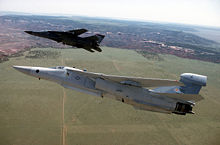AN / ALQ-99

The AN / ALQ-99 is an airborne system for electronic countermeasures and electronic reconnaissance over medium to long distances. It is produced by the US group ITT Corporation .
description
The ALQ-99 is housed in an external container and can therefore be easily attached to a suitable weapon station under the wings of the carrier aircraft. The system receives the electricity it needs from a Ram Air turbine , which is attached to the top of the container. The ALQ-99 can work largely autonomously, but in almost all cases there is a connection to the on-board systems of the carrier aircraft, which can significantly increase efficiency.
The system is designed to interfere with powerful search and fire control radars (e.g. from SAM positions) over long distances (“distance interference”). For this purpose, two to four directional antennas are primarily used, which are aimed at the transmitter to be disrupted. This focusing greatly increases the efficiency of the system with respect to a single target, especially when the interference is caused by noise . The core of the system are several traveling wave tubes , which significantly amplify the interference signals before they are transmitted. Over time, the frequency range of the ALQ-99 has been continuously expanded. With the introduction of LBT modules (“Low Band Transmitter”), the system can now also interfere with radars and communication systems in low frequency ranges, whereby a fully automatic operating mode can now also be used, which reacts independently to hostile transmitters.
The ALQ-99 has been used in many conflicts and has proven to be very effective. The first missions took place in the Vietnam conflict (1972–1973).
Platforms
- EA-6B Prowler
- EA-18G growler
- EF-111A Raven (decommissioned)
Technical specifications
- Length: 4.85 m
- Width: 0.46-0.66 m
- Height: 0.71 m
- Weight: 435 kg
- Radiant power: 8.0-17.7 kW
- Power consumption: max. 27 kW
- Frequency ranges:
- Band 1: 0.064-0.15 GHz
- Band 2: 0.15-0.27 GHz
- Band 3: 0.27-0.5 GHz
- Band 4: 0.5-1 GHz
- Band 5/6: 1-1.25 GHz
- Band 7: 2.5-4 GHz
- Band 8: 4-7.8 GHz
- Band 9: 7.8-11 GHz
- Band 10: 11-20 GHz
Web links
- Federation Of American Scientists
- Manufacturer's website ( Memento from May 11, 2008 in the Internet Archive ) (English)
